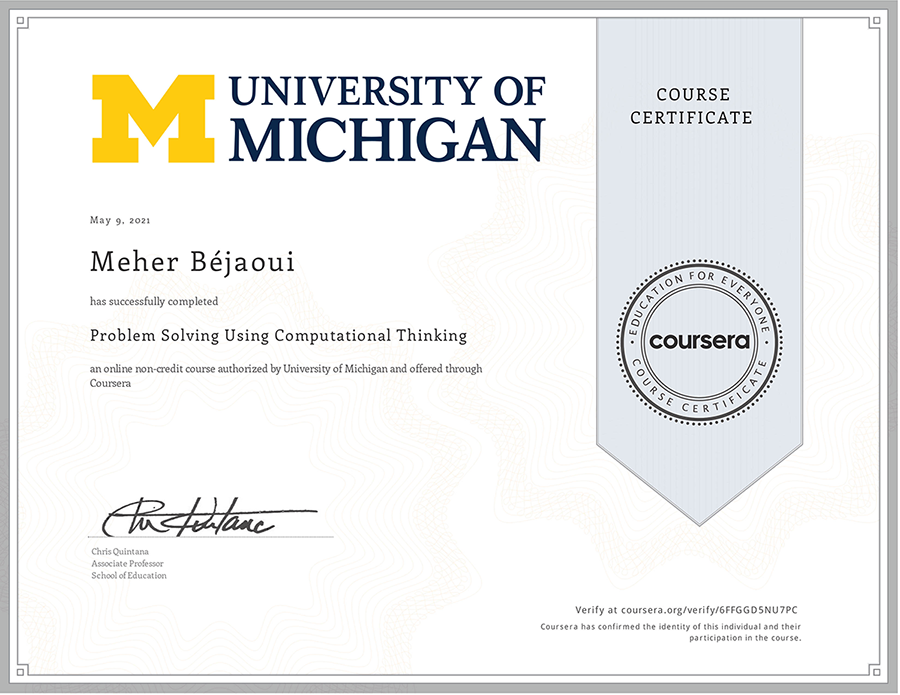Problem Solving Using Computational Thinking - Course Review
For their 9th birthday, Coursera celebrated by offering their learners a collection of 9 coursers to pick from, and enrol to earn a free certificate (special offer was available through 30 April 2021). I chose Problem Solving Using Computational Thinking from the University of Michigan.
In this article, I will share some insights about the course, and what you can expect if you decide to take it on.
Course overview and structure
First, the course is taught entirely in English, but there are subtitles for other languages as well (currently French, Portuguese (European), Russian and Spanish).
In week 1, you will learn about the foundations of Computational Thinking from Associate Professor Chris Quintana, from the University of Michigan School of Education. Then, you will have the opportunity to see Computational Thinking through real world and hypothetical examples shared by three experts in weeks 2, 3 and 4.
These experts are, respectively, Associate Director Mariana Carrasco-Teja from the Michigan Institute for Computational Discovery and Engineering (airport surveillance and image analysis case study); Associate Professor Rafael Meza (epidemiology case study); and Instructional and Program Design Coordinator Darin Stockdil from the Center for Education Design, Evaluation, and Research (human trafficking case study).
The learning objectives are:
-
To define Computational Thinking components including abstraction, problem identification, decomposition, pattern recognition, algorithms, and evaluating solutions.
-
To recognize Computational Thinking concepts in practice through a series of real-world case examples.
-
And to develop solutions through the application of Computational Thinking concepts to real world problems (peer-graded assignment).
The course is structured in 5 weeks, with the last being a peer-graded final project. To review the learning material, do the practice quizzes and quizzes, it should take you around 2 hours per week for the first 3 weeks, and 1h15 for the 4th week (excluding the time required for discussion prompts).
That would surely depend on your own pace and learning style, and you should always devote enough time, and work through the material appropriately. As for the last week, I find it the most challenging, and it would take you longer than indicated. Allow and plan for at least 3 hours of work in that week.
Course review
My overall remarks and opinions regarding the course are:
- Videos are not too long or too short. They are just about the right length for you to follow and focus in every segment, take a break and get back to another video.
-
Some parts would require very careful attention, and perhaps repeated reviewing of the material. That is because of their complexity for a non-specialized audience.
-
The course introduces new concepts, ideas and technologies from a variety of fields and domains. It brings richness of content, and should broaden one’s knowledge beyond the computational thinking aspects. You learn different things in just one course.
-
The course is well suited and appropriate for various skill levels. Even advanced learners can consolidate their knowledge and learn something new.
-
There are enough practice quizzes and quizzes for a learner to test their understanding. However, some questions require the student to fill-in their answers, and that might not always be the best method.
-
Not a lot of in-video questions.
-
The videos look scripted, with prepared speeches in advance. However, some videos are not as fluid or comprehensible. If necessary, you can use the subtitles.
-
Estimated times for completion of quizzes are a bit off.
- There are no reading materials and other resources.
Note that the case for the 4th week is optional. You will need to consent to be able to read and examine the course material. That is because the case study covers a rather delicate topic regarding hypothetical implications of Computational Thinking on the issue of Human Trafficking.
I have taken many courses from the University of Michigan. This course is true to their approach and methodology. It is well structured, with professional high quality videos and production.
The case studies are meticulously presented, and I think they bring the most value to the course. And when working on the last peer-graded assignment, you get the chance to apply and test your knowledge to the fullest.
Perhaps the thing that can be improved, is the quality of discussion forums.
Overall, I do recommend taking Problem Solving Using Computational Thinking, and investing the time to complete the course.
Happy learning everyone!

Leave a comment